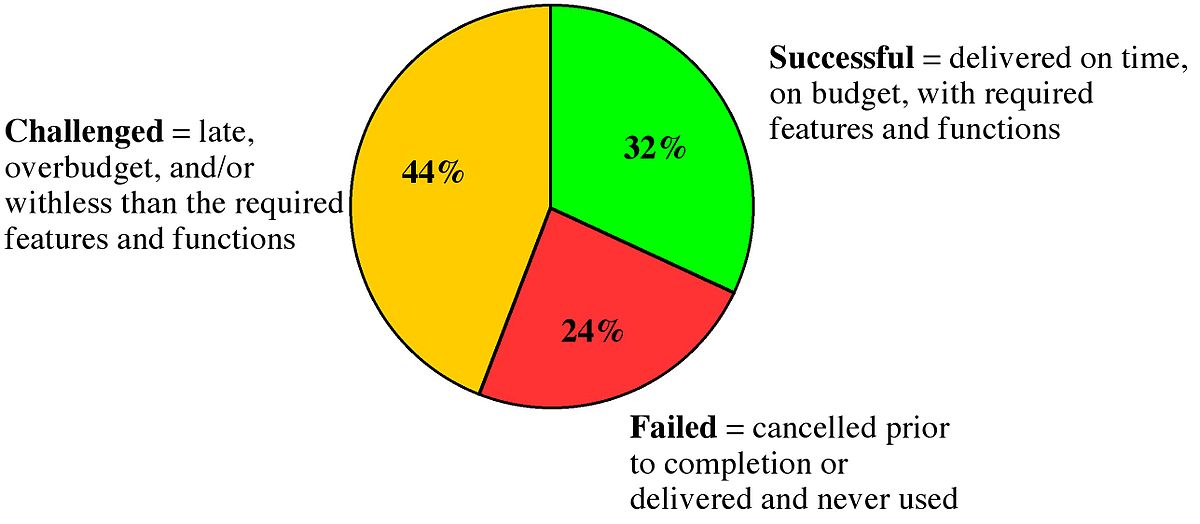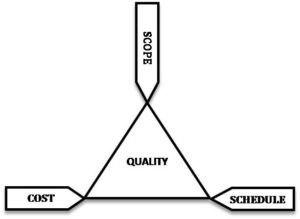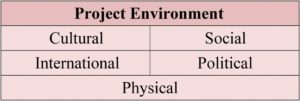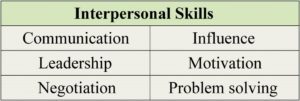How Quickly Does Social Structure Tend To Change?
Master Body
2. Project Management Overview
The starting point in discussing how projects should exist properly managed is to first understand what a project is and, just as importantly, what information technology is non.
People have been undertaking projects since the earliest days of organized human being activity. The hunting parties of our prehistoric ancestors were projects, for example; they were temporary undertakings directed at the goal of obtaining meat for the community. Large complex projects have as well been with us for a long time. The pyramids and the Neat Wall of Cathay were in their day of roughly the same dimensions as the Apollo project to send men to the moon. We use the term "project" frequently in our daily conversations. A hubby, for example may tell his wife, "My main project for this weekend is to straighten out the garage." Going hunting, building pyramids, and fixing faucets all share sure features that make them projects.
Project Attributes
A project has distinctive attributes that distinguish it from ongoing work or business operations. Projects are temporary in nature. They are non an everyday concern procedure and have definitive beginning dates and end dates. This characteristic is of import because a large part of the project effort is dedicated to ensuring that the projection is completed at the appointed fourth dimension. To do this, schedules are created showing when tasks should begin and stop. Projects can last minutes, hours, days, weeks, months, or years.
Projects exist to bring about a product or service that hasn't existed before. In this sense, a project is unique. Unique means that this is new; this has never been done before. Possibly it'south been done in a very similar style before merely never exactly in this way. For example, Ford Motor Company is in the business organisation of designing and assembling cars. Each model that Ford designs and produces can be considered a project. The models differ from each other in their features and are marketed to people with diverse needs. An SUV serves a different purpose and clientele than a luxury car. The design and marketing of these two models are unique projects. Even so, the bodily assembly of the cars is considered an operation (i.e., a repetitive process that is followed for most makes and models).
In contrast with projects, operations are ongoing and repetitive. They involve piece of work that is continuous without an catastrophe date and with the aforementioned processes repeated to produce the same results. The purpose of operations is to go on the organization operation while the purpose of a project is to meet its goals and conclude. Therefore, operations are ongoing while projects are unique and temporary.
A projection is completed when its goals and objectives are accomplished. Information technology is these goals that bulldoze the project, and all the planning and implementation efforts undertaken to achieve them. Sometimes projects stop when it is determined that the goals and objectives cannot be accomplished or when the product or service of the project is no longer needed and the projection is cancelled.
Definition of a Projection
There are many written definitions of a project. All of them contain the key elements described above. For those looking for a formal definition of a project, the Project Direction Plant (PMI) defines a project as a temporary endeavor undertaken to create a unique product, service, or result. The temporary nature of projects indicates a definite beginning and terminate. The terminate is reached when the project'south objectives have been achieved or when the projection is terminated considering its objectives will not or cannot exist met, or when the need for the project no longer exists.
Projection Characteristics
When considering whether or not y'all take a projection on your hands, there are some things to go on in mind. First, is it a project or an ongoing operation? 2d, if it is a project, who are the stakeholders? And third, what characteristics distinguish this endeavor as a project?
Projects take several characteristics:
- Projects are unique.
- Projects are temporary in nature and take a definite kickoff and ending engagement.
- Projects are completed when the project goals are achieved or it's determined the projection is no longer viable.
A successful projection is ane that meets or exceeds the expectations of the stakeholders.
Consider the following scenario: The vice-president (VP) of marketing approaches you with a fabulous thought. (Obviously it must be "fabled" because he idea of it.) He wants to fix kiosks in local grocery stores as mini-offices. These offices volition offer customers the ability to sign up for automobile and home insurance services besides every bit make their bill payments. He believes that the exposure in grocery stores will increase sensation of the company'south offerings. He told you that senior management has already cleared the projection, and he'll dedicate as many resources to this as he tin. He wants the new kiosks in place in 12 selected stores in a major city by the finish of the twelvemonth. Finally, he has assigned you lot to head upwardly this project.
Your outset question should be, "Is it a project?" This may seem uncomplicated, but confusing projects with ongoing operations happens often. Projects are temporary in nature, have definite start and terminate dates, result in the creation of a unique production or service, and are completed when their goals and objectives have been met and signed off past the stakeholders.
Using these criteria, allow'due south examine the assignment from the VP of marketing to determine if information technology is a project:
- Is it unique? Yes, considering the kiosks don't exist in the local grocery stores. This is a new way of offering the visitor's services to its client base. While the service the company is offer isn't new, the way it is presenting its services is.
- Does the product have a limited timeframe? Yes, the start date of this project is today, and the end date is the finish of next year. It is a temporary endeavor.
- Is at that place a way to determine when the projection is completed? Yeah, the kiosks will be installed and the services will exist offered from them. In one case all the kiosks are installed and operating, the project volition come to a close.
- Is there a manner to decide stakeholder satisfaction? Yes, the expectations of the stakeholders will exist documented in the grade of requirements during the planning processes. These requirements volition be compared to the finished production to determine if it meets the expectations of the stakeholder.
If the answer is yes to all these questions, so we have a project.
The Process of Project Management
You lot've determined that you take a project. What at present? The notes you scribbled down on the dorsum of the napkin at lunch are a beginning, just not exactly skillful projection management practice. Besides oftentimes, organizations follow Nike's advice when information technology comes to managing projects when they "just exercise information technology." An assignment is fabricated, and the projection team members bound directly into the development of the product or service requested. In the stop, the delivered product doesn't meet the expectations of the customer. Unfortunately, many projects follow this poorly constructed path, and that is a chief contributor to a large percentage of projects not meeting their original objectives, equally defined past performance, schedule, and upkeep.
In the United States, more than than $250 billion is spent each year on data technology (IT) application development in approximately 175,000 projects. The Standish Group (a Boston-based leader in project and value performance research) released the summary version of their 2009 Anarchy Report that tracks project failure rates across a broad range of companies and industries (Figure two.ane).

Jim Johnson, chairman of the Standish Grouping, has stated that "this year's results show a marked decrease in projection success rates, with 32% of all projects succeeding which are delivered on fourth dimension, on budget, with required features and functions, 44% were challenged-which are belatedly, over budget, and/or with less than the required features and functions and 24% failed which are cancelled prior to completion or delivered and never used."
When are companies going to stop wasting billions of dollars on failed projects? The vast majority of this waste material is completely avoidable: simply get the correct concern needs (requirements) understood early in the process and ensure that projection management techniques are applied and followed, and the project activities are monitored.
Applying good projection management discipline is the style to help reduce the risks. Having good projection management skills does non completely eliminate problems, risks, or surprises. The value of good project management is that y'all have standard processes in place to bargain with all contingencies.
Projection management is the application of knowledge, skills, tools, and techniques applied to project activities in order to meet the project requirements. Projection management is a procedure that includes planning, putting the project programme into activeness, and measuring progress and performance.
Managing a project includes identifying your projection's requirements and writing down what everyone needs from the project. What are the objectives for your project? When everyone understands the goal, it's much easier to keep them all on the right path. Make sure you prepare goals that anybody agrees on to avoid team conflicts afterward on. Agreement and addressing the needs of everyone affected past the project means the stop result of your project is far more likely to satisfy your stakeholders. Last but non least, equally project manager, y'all volition as well be balancing the many competing projection constraints.
On whatever project, you will have a number of project constraints that are competing for your attention. They are cost, scope, quality, take chances, resources, and time.
- Cost is the budget approved for the projection including all necessary expenses needed to deliver the project. Inside organizations, project managers accept to balance between not running out of money and not underspending because many projects receive funds or grants that have contract clauses with a "use it or lose information technology" approach to projection funds. Poorly executed budget plans tin result in a concluding-infinitesimal rush to spend the allocated funds. For virtually all projects, cost is ultimately a limiting constraint; few projects tin can go over upkeep without eventually requiring a corrective action.
- Scope is what the projection is trying to reach. It entails all the work involved in delivering the project outcomes and the processes used to produce them. It is the reason and the purpose of the projection.
- Quality is a combination of the standards and criteria to which the project'southward products must exist delivered for them to perform effectively. The product must perform to provide the functionality expected, solve the identified problem, and deliver the benefit and value expected. Information technology must likewise run into other performance requirements, or service levels, such as availability, reliability, and maintainability, and have adequate finish and polish. Quality on a project is controlled through quality assurance (QA), which is the process of evaluating overall project performance on a regular basis to provide confidence that the projection will satisfy the relevant quality standards.
- Risk is defined by potential external events that will accept a negative impact on your project if they occur. Risk refers to the combination of the probability the event will occur and the affect on the project if the outcome occurs. If the combination of the probability of the occurrence and the impact on the project is too high, you should identify the potential consequence as a risk and put a proactive programme in place to manage the take a chance.
- Resources are required to carry out the project tasks. They tin exist people, equipment, facilities, funding, or anything else capable of definition (unremarkably other than labour) required for the completion of a project activity.
- Time is defined as the time to complete the project. Time is often the most frequent projection oversight in developing projects. This is reflected in missed deadlines and incomplete deliverables. Proper control of the schedule requires the careful identification of tasks to be performed and accurate estimations of their durations, the sequence in which they are going to be washed, and how people and other resources are to be allocated. Any schedule should take into account vacations and holidays.
You may have heard of the term "triple constraint," which traditionally consisted of only fourth dimension, toll, and scope. These are the principal competing project constraints that you have to exist most aware of. The triple constraint is illustrated in the form of a triangle to visualize the project work and see the relationship between the scope/quality, schedule/time, and cost/resource (Figure ii.2). In this triangle, each side represents i of the constraints (or related constraints) wherein any changes to any one side cause a modify in the other sides. The best projects have a perfectly counterbalanced triangle. Maintaining this balance is difficult because projects are prone to change. For example, if scope increases, cost and time may increase unduly. Alternatively, if the amount of money you have for your project decreases, you may be able to do as much, simply your time may increase.

Your project may have additional constraints that you must face, and equally the project managing director, y'all accept to balance the needs of these constraints against the needs of the stakeholders and your project goals. For example, if your sponsor wants to add functionality to the original scope, you will very probable demand more money to end the projection, or if they cut the budget, you will take to reduce the quality of your scope, and if you don't get the appropriate resources to piece of work on your project tasks, you volition accept to extend your schedule considering the resource you lot have take much longer to end the work.
Y'all get the idea; the constraints are all dependent on each other. Think of all of these constraints equally the classic carnival game of Whac-a-mole (Figure 2.three). Each time you try to button one mole back in the hole, another one pops out. The all-time advice is to rely on your project team to go along these moles in identify.

Hither is an instance of a project that cut quality because the project costs were fixed. The P-36 oil platform (Figure 2.four) was the largest ground product platform in the world capable of processing 180,000 barrels of oil per day and 5.two million cubic metres of gas per day. Located in the Roncador Field, Campos Bowl, Brazil, the P-36 was operated by Petrobras.

In March 2001, the P-36 was producing around 84,000 barrels of oil and one.3 1000000 cubic metres of gas per day when information technology became destabilized by two explosions and subsequently sank in three,900 feet of water with i,650 short tons of crude oil remaining on board, killing eleven people. The sinking is attributed to a consummate failure in quality assurance, and pressure for increased production led to corners being cut on safety procedures. It is listed as one of the nearly expensive accidents with a toll tag of $515,000,000.
The post-obit quotes are from a Petrobras executive, citing the benefits of cutting quality balls and inspection costs on the project.
"Petrobras has established new global benchmarks for the generation of exceptional shareholder wealth through an ambitious and innovative plan of toll cutting on its P36 production facility."
"Conventional constraints have been successfully challenged and replaced with new paradigms advisable to the globalized corporate market place place."
"Elimination of these unnecessary straitjackets has empowered the project's suppliers and contractors to propose highly economic solutions, with the win-win bonus of enhanced profitability margins for themselves."
"The P36 platform shows the shape of things to come in the unregulated global market economy of the 21st century."
The dynamic trade-offs between the project constraint values have been humorously and accurately described in Figure 2.5.

Project Direction Expertise
In order for you, as the project director, to manage the competing project constraints and the project as a whole, there are some areas of expertise y'all should bring to the project team (Effigy 2.xi). They are knowledge of the awarding area and the standards and regulations in your manufacture, understanding of the project environment, general management knowledge and skills, and interpersonal skills. It should be noted that industry expertise is not in a certain field but the expertise to run the projection. So while knowledge of the type of manufacture is important, y'all will have a project team supporting yous in this effort. For example, if you are managing a project that is edifice an oil platform, you would not be expected to take a detailed understanding of the engineering since your team will have mechanical and civil engineers who will provide the appropriate expertise; however, it would definitely help if you understood this type of piece of work.
Let's have a look at each of these areas in more item.
Application knowledge
By standards, we hateful guidelines or preferred approaches that are non necessarily mandatory. In dissimilarity, when referring to regulations we mean mandatory rules that must be followed, such as government-imposed requirements through laws. It should go without saying that equally a professional, you lot're required to follow all applicable laws and rules that apply to your manufacture, organization, or project. Every industry has standards and regulations. Knowing which ones impact your project earlier yous brainstorm work will not merely help the projection to unfold smoothly, just will also allow for effective take a chance assay.

Some projects crave specific skills in certain application areas. Awarding areas are fabricated up of categories of projects that accept mutual elements. They can be divers by industry group (pharmaceutical, financial, etc.), department (accounting, marketing, legal, etc.), technology (software development, applied science, etc), or management specialties (procurement, research and development, etc.). These awarding areas are usually concerned with disciplines, regulations, and the specific needs of the project, the customer, or the industry. For example, nigh regime agencies take specific procurement rules that apply to their projects that wouldn't be applicable in the construction industry. The pharmaceutical industry is interested in regulations set forth past government regulators, whereas the automotive industry has little or no business for either of these types of regulations. You need to stay up-to-appointment regarding your industry and then that you can apply your knowledge effectively. Today'south fast-paced advances can leave y'all behind fairly quickly if you don't stay beside of electric current trends.
Having some level of experience in the application area you're working in will requite you an advantage when it comes to projection direction. While you lot can telephone call in experts who have the application expanse knowledge, it doesn't hurt for you to understand the specific aspects of the awarding areas of your project.
Understanding the Project Environment
There are many factors that need to be understood inside your project environment (Figure 2.7). At i level, yous demand to remember in terms of the cultural and social environments (i.eastward., people, demographics, and instruction). The international and political environment is where you need to sympathise most different countries' cultural influences. So we move to the concrete environment; hither we think about time zones. Think about different countries and how differently your project volition be executed whether information technology is just in your country or if information technology involves an international project team that is distributed throughout the world in five different countries.

Of all the factors, the concrete ones are the easiest to sympathise, and information technology is the cultural and international factors that are oft misunderstood or ignored. How we deal with clients, customers, or project members from other countries tin can exist critical to the success of the project. For example, the culture of the United States values accomplishments and individualism. Americans tend to be informal and telephone call each other by first names, even if having just met. Europeans tend to be more formal, using surnames instead of first names in a business organisation setting, even if they know each other well. In addition, their advice mode is more formal than in the United states, and while they tend to value individualism, they as well value history, hierarchy, and loyalty. The Japanese, on the other hand, tend to communicate indirectly and consider themselves part of a group, not as individuals. The Japanese value hard work and success, as most of u.s. do.
How a product is received can be very dependent on the international cultural differences. For example, in the 1990s, when many large American and European telecommunications companies were cultivating new markets in Asia, their customer's cultural differences oft produced unexpected situations. Western companies planned their telephone systems to work the same style in Asia as they did in Europe and the United states. But the protocol of conversation was different. Telephone call-waiting, a popular feature in the West, is considered impolite in some parts of Asia. This cultural corrigendum could have been avoided had the team captured the projection environment requirements and involved the client.
Information technology is often the simplest things that can cause trouble since, unsurprisingly, in different countries, people do things differently. One of the most notorious examples of this is also one of the near simple: date formats. What day and calendar month is 2/8/2009? Of course it depends where y'all come up from; in Northward America it is February 8th while in Europe (and much of the residuum of the globe) it is 2nd August. Clearly, when schedules and deadlines are existence defined information technology is of import that anybody is clear on the format used.
The variety of practices and cultures and its impact on products in general and on software in particular goes well beyond the engagement issue. Yous may be managing a projection to create a new website for a company that sells products worldwide. There are language and presentation style issues to take into consideration; converting the site into different languages isn't enough. Information technology is obvious that yous demand to ensure the translation is right; yet, the presentation layer volition have its own set of requirements for unlike cultures. The left side of a website may exist the get-go focus of attention for a Canadian; the right side would be the initial focus for anyone from the Middle East, as both Standard arabic and Hebrew are written from correct to left. Colors also accept different meanings in different cultures. White, which is a sign of purity in Northward America (east.one thousand., a bride's hymeneals wearing apparel), and thus would exist a favoured background colour in Due north America, signifies decease in Nippon (e.m., a burial shroud). Table ii.i summarizes different meanings of common colours.
| Colour | Usa | China | Japan | Arab republic of egypt | French republic |
|---|---|---|---|---|---|
| Cherry | Danger, stop | Happiness | Anger, danger | Death | Elite |
| Blueish | Sadness, melancholy | Heavens, clouds | Villainy | Virtue, organized religion, truth | Freedom, peace |
| Green | Novice, apprentice | Ming dynasty, heavens | Future, youth, energy | Fertility, force | Criminality |
| Yellow | Cowardice | Birth, wealth | Grace, nobility | Happiness, prosperity | Temporary |
| White | Purity | Death, purity | Expiry | Joy | Naturality |
Project managers in multicultural projects must appreciate the civilisation dimensions and try to learn relevant customs, courtesies, and business protocols before taking responsibility for managing an international project. A project manager must have into consideration these various cultural influences and how they may affect the projection'due south completion, schedule, scope, and cost.
Management Knowledge and Skills
As the project manager, you take to rely on your projection management cognition and your general management skills. Here, we are thinking of items like your ability to plan the projection, execute information technology properly, and of course control information technology and bring information technology to a successful determination, forth with your ability to guide the project team to accomplish project objectives and remainder project constraints.
In that location is more to project management than just getting the piece of work done. Inherent in the process of project management are the general direction skills that allow the project managing director to complete the project with some level of efficiency and control. In some respects, managing a project is similar to running a business organisation: there are risk and rewards, finance and bookkeeping activities, human resource issues, fourth dimension direction, stress management, and a purpose for the project to be. General management skills are needed in every project.
Interpersonal Skills
Last merely not least you also have to bring the power into the projection to manage personal relationships and deal with personnel issues as they arise. Here were talking about your interpersonal skills as shown in Figure ii.8.
Communication
Project managers spend 90% of their time communicating. Therefore they must be good communicators, promoting articulate, unambiguous exchange of information. As a projection manager, information technology is your task to go along a number of people well informed. It is essential that your projection staff know what is expected of them: what they have to do, when they take to do information technology, and what budget and time constraints and quality specifications they are working toward. If projection staff members exercise not know what their tasks are, or how to attain them, then the entire projection will grind to a halt. If you do non know what the project staff is (or oft is not) doing, then you lot will be unable to monitor project progress. Finally, if you are uncertain of what the customer expects of yous, so the project will not even become off the ground. Project advice can thus be summed up as knowing "who needs what information and when" and making certain they have it.

All projects crave sound communication plans, but not all projects will accept the aforementioned types of communication or the aforementioned methods for distributing the data. For example, volition information be distributed via mail or e-mail, is there a shared website, or are face-to-face meetings required? The communication management plan documents how the communication needs of the stakeholders will exist met, including the types of data that will exist communicated, who will communicate them, and who will receive them; the methods used to communicate; the timing and frequency of communication; the method for updating the plan as the project progresses, including the escalation process; and a glossary of common terms.
Influence
Projection management is about getting things done. Every organization is different in its policies, modes of operations, and underlying civilisation. There are political alliances, differing motivations, conflicting interests, and power struggles. A project manager must understand all of the unspoken influences at piece of work inside an organisation.
Leadership
Leadership is the ability to motivate and inspire individuals to work toward expected results. Leaders inspire vision and rally people effectually common goals. A good project manager can motivate and inspire the project team to run across the vision and value of the project. The project manager as a leader can inspire the projection team to find a solution to overcome perceived obstacles to get the piece of work done.
Motivation
Motivation helps people work more efficiently and produce better results. Motivation is a abiding process that the project manager must guide to help the team motility toward completion with passion and a profound reason to complete the work. Motivating the team is achieved past using a variety of team-edifice techniques and exercises. Team building is simply getting a various group of people to piece of work together in the most efficient and constructive manner possible. This may involve management events every bit well as private actions designed to meliorate team performance.
Recognition and rewards are an important role of team motivations. They are formal ways of recognizing and promoting desirable behaviour and are almost constructive when carried out past the management squad and the project manager. Consider individual preferences and cultural differences when using rewards and recognition. Some people don't like to be recognized in front of a grouping; others thrive on information technology.
Negotiation
Project managers must negotiate for the practiced of the projection. In any project, the project manager, the project sponsor, and the projection team will have to negotiate with stakeholders, vendors, and customers to reach a level of agreement adequate to all parties involved in the negotiation process.
Problem Solving
Problem solving is the ability to understand the heart of a problem, look for a viable solution, and then make a conclusion to implement that solution. The starting indicate for problem solving is problem definition. Problem definition is the ability to empathise the cause and upshot of the trouble; this centres on root-cause analysis. If a projection manager treats just the symptoms of a problem rather than its cause, the symptoms will perpetuate and continue through the project life. Even worse, treating a symptom may result in a greater problem. For instance, increasing the ampere rating of a fuse in your car because the old ane keeps blowing does not solve the problem of an electric short that could upshot in a fire. Root-cause assay looks beyond the immediate symptoms to the crusade of the symptoms, which then affords opportunities for solutions. Once the root of a trouble has been identified, a conclusion must exist made to effectively address the trouble.
Solutions tin can be presented from vendors, the project team, the projection managing director, or diverse stakeholders. A feasible solution focuses on more than just the problem; it looks at the cause and consequence of the solution itself. In addition, a timely determination is needed or the window of opportunity may pass and then a new decision will be needed to address the trouble. Equally in most cases, the worst affair y'all tin do is nil.
All of these interpersonal skills will be used in all areas of project management. Offset practicing at present because information technology'south guaranteed that y'all'll need these skills on your next project.
Epitome Descriptions
Figure 2.5 image description: The sign says, "We can practice good, quick, and inexpensive work. Yous tin can have whatever 2 but non all three. 1. Good, quick work won't be cheap. 2. Good, cheap piece of work won't be quick. 3. Quick, cheap work won't be good." [Return to Figure 2.5]
Text Attributions
- This chapter of Project Management is a derivative of Projection Management by Merrie Barron and Andrew Barron. © CC BY (Attribution).
- Table two.1: Adapted from P. Russo and Southward. Boor, How Fluent is Your Interface? Designing for International Users, Proceedings of the INTERACT '93 and CHI '93, Association for Computing Mechanism, Inc. (1993). Table from Barron & Barron Project Management for Scientists and Engineers, Source: Project Direction for Scientists and Engineers by Merrie Barron; Andrew R. Barron
Source: https://opentextbc.ca/projectmanagement/chapter/chapter-2-what-is-a-project-project-management/
Posted by: duranhishentimed.blogspot.com


0 Response to "How Quickly Does Social Structure Tend To Change?"
Post a Comment